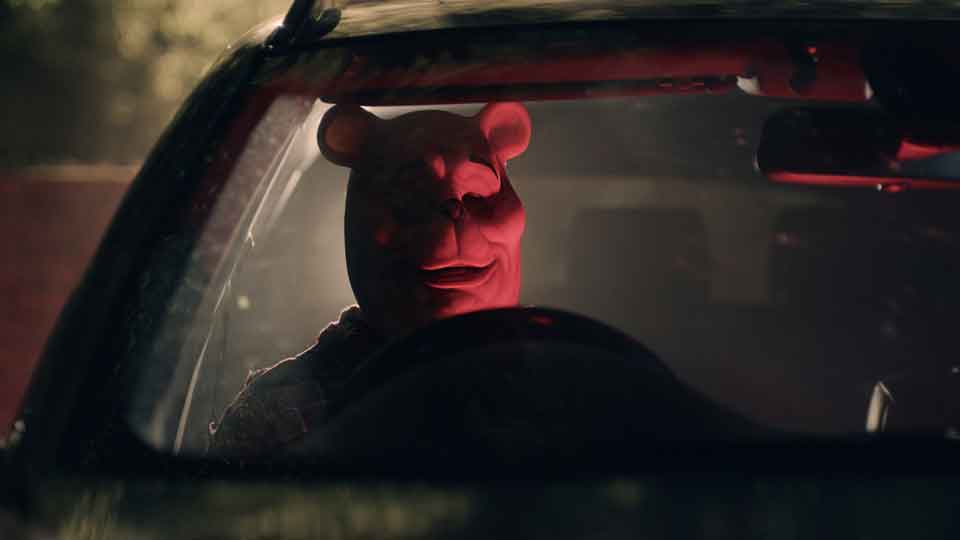“If you go down to the woods today, you’re sure of a big surprise.” The once-magical lyrics of the children’s song “The Teddy Bears’ Picnic” turn into an ominous warning in the opening credits of Winnie-the-Pooh: Blood and Honey, in theaters Feb. 15.
Written and directed by Rhys Frake-Waterfield (The Area 51 Incident, Firenado), Blood and Honey follows a deformed Pooh (Craig David Dowsett) and Piglet (Chris Cordell) as they descend into a murderous rampage after Christopher Robin (Nikolai Leon) leaves them behind to go to college. Forced to fend for themselves, the creatures of the Hundred Acre Wood begin eating each other (R.I.P. Eeyore) and turn feral.
Five years later, Christopher Robin returns to the woods with his wife Mary (Paula Coiz) in hopes of introducing her to his childhood friends and proving they weren’t imaginary. Instead, the couple is terrorized by the anthropomorphic monsters that Pooh and Piglet have become, and a brutal killing spree begins.
The Pooh and Piglet of Blood and Honey are a far cry from the beloved characters created by English author A.A. Milne and later adapted for film and television by Disney—and have generated quite the controversy. Frake-Waterfield told the Agence France-Presse that he’s received death threats over his horror reimagining of the classic Winnie-the-Pooh story.
“I’ve had petitions to stop it,” he said. “I’ve had death threats. I’ve had people saying they called the police.”
However, the movie, reportedly made for under $100,000, has also garnered a significant amount of online attention and already earned $1 million in Mexico since its Jan. 26 premiere. This prompted the film’s distributor, Fathom Events, to expand its U.S. launch from what would have been a one-night-only release to a nine-day run in more than 1,500 theaters nationwide.

So how exactly did the R-rated Blood and Honey come to be? Although Disney still owns the rights to the animated cartoon versions of Pooh Bear and company, A.A. Milne’s 1926 book Winnie-the-Pooh entered the public domain on Jan. 1, 2022. That means that Milne’s original story, as well as illustrator E.H. Shepard’s drawings of Pooh, Piglet, Rabbit, Kanga, Roo, Owl, Eeyore, and Christopher Robin, all became fair game for any and all types of adaptations following the end of the 95-year copyright protection term.
Frake-Waterfield wasted no time jumping on the opportunity to incorporate the characters into his microbudget slasher flick, with production on Blood and Honey starting early last year. But the director also seems to have taken pains to avoid bringing down Disney’s iron copyright hammer. For instance, the Pooh of Blood and Honey is wearing a red flannel button-up rather than the red t-shirt of Disney Pooh fame, and popular characters like Tigger don’t appear in the film.
“We’ve tried to be extremely careful,” he told Variety last year. “We knew there was this line between that, and we knew what their copyright was and what they’ve done. So we did as much as we could to make sure [the film] was only based on the 1926 version of it.”
Still, Blood and Honey has largely been panned by critics, with its Rotten Tomatoes score currently sitting at 8%. “The goal of Winnie-the-Pooh: Blood and Honey was clearly to ruin your childhood,” wrote The Daily Beast‘s Nick Schager. “The bizarrely uninspired horror disaster will make you wish you kept your money instead.”
More Must-Reads From TIME
- The 100 Most Influential People of 2024
- The Revolution of Yulia Navalnaya
- 6 Compliments That Land Every Time
- What's the Deal With the Bitcoin Halving?
- If You're Dating Right Now , You're Brave: Column
- The AI That Could Heal a Divided Internet
- Fallout Is a Brilliant Model for the Future of Video Game Adaptations
- Want Weekly Recs on What to Watch, Read, and More? Sign Up for Worth Your Time
Write to Megan McCluskey at megan.mccluskey@time.com